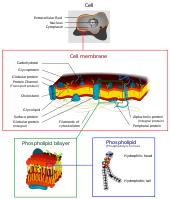
Photo from wikipedia
Composition and asymmetry of lipid membranes provide a means for regulation of trans-membrane permeability of ions and small molecules. The pH dependence of these processes plays an important role in… Click to show full abstract
Composition and asymmetry of lipid membranes provide a means for regulation of trans-membrane permeability of ions and small molecules. The pH dependence of these processes plays an important role in the functioning and survival of cells. In this work, we study the pH dependence of membrane electrical resistance and capacitance using electrochemical impedance spectroscopy (EIS), surface plasmon resonance (SPR) and neutron reflectometry (NR) measurements of biomimetic tethered bilayer lipid membranes (tBLMs). tBLMs were prepared with single-component phospholipid compositions, as well as mixtures of phospholipids (phosphatidylcholine, phosphatidylserine, phosphatidylethanolamine, sphingomyelin and cholesterol) that mimic the inner- and outer- leaflets of plasma cell membranes. We found that all studied tBLMs have a resistance maximum at pHs near the pKas of the phospholipids. SPR and NR indicated that surface concentration of phospholipids and the thickness of the hydrophobic part of the membrane did not change versus pH. We postulate that these maxima are the result of protonation of the phosphate oxygen of the phospholipids and that hydronium ions play a major role in the conductance at pHs < pKas while sodium ions play the major role at pHs > pKas. An additional sharp resistance maximum of the PE tBLMs found at pH 5.9 and most likely represents the phosphatidylethanolamine's isoelectric point. The data show the key roles of the characteristic parts of phospholipid molecules: terminal group (choline, carboxyl, amine), phosphate, glycerol and ester oxygens on the permeability and selectivity of ions through the membrane. The interactions between these groups lead to significant differences in the electrical properties of biomimetic models of inner- and outer- leaflets of the plasma cell membranes.
Journal Title: Journal of colloid and interface science
Year Published: 2021
Link to full text (if available)
Share on Social Media: Sign Up to like & get
recommendations!